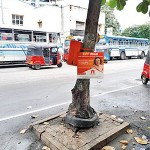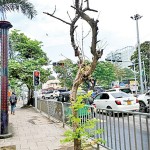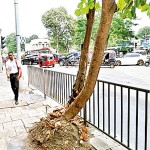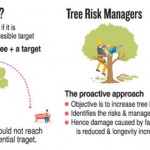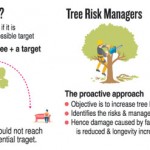News
Chop, chop, chop not the answer to avert tree tragedies
View(s):Horticulture and Landscape Gardening expert Prof. Kapila Yakandawala stresses the importance of a Tree Management Plan to safeguard the lungs of our cities while ensuring the safety of the public
By Kumudini Hettiarachchi
A Tree Registry and a comprehensive Tree Management Plan are essential for urban areas to prevent tragedies such as Colombo’s Duplication Road tree accident, while ensuring the survival of these vital eco-system partners.
Hot on the heels of tree tragedies, knee-jerk reactions of speedily cutting down trees should be a clear ‘no, no’ without a proper risk assessment, says expert Prof. KapilaYakandawala, reiterating how trees act as “our lungs” in cities by cleaning the air of pollutants, helping to cool the environment and supporting mental health.
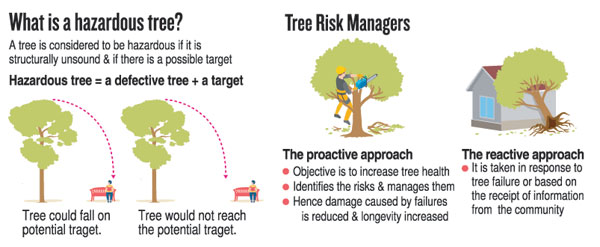
He is adamant that there is no need to go around axing or chopping down all the trees in cities such as Colombo and Kandy. “We can hold fast to the compliment of Colombo being a beautiful ‘Garden City’ while making sure that people are safe,” says Prof. Yakandawala.

Prof. Kapila Yakandawala
This expert knows what he is talking about as he is the Wayamba University’s Chair of Horticulture and Landscape Gardening, Department of Horticulture & Landscape Gardening, Faculty of Agriculture & Plantation Management.
His technical advice and need for safety come in the wake of a tree crashing down on a long-distance bus very close to the Liberty Plaza roundabout in Colombo 3, on Duplication Road (R.A. de Mel Mawatha), leaving five people dead.
Delving into ‘Tree Risk Management’ (TRM), Prof. Yakandawala says that usually what happens after a tree-fall tragedy is the ‘reactive approach’, responding to a tree failure or on receiving information from people about the possibility of a tree or a branch crashing down.
However, he stresses, the need is the ‘proactive approach’ with the objective of increasing tree health and identifying and managing risks. This results in mitigating and reducing harm and damage being caused by tree failures and increasing the longevity of trees.
- Prof. Kapila Yakandawala
- The paving around the tree is up to the trunk, while a tyre used to provide protection when the tree was young has not been removed. Photographed on Union Place in Colombo in January 2020
- The tree is dead but water sprouts are coming out – photographed on Union Place in Colombo in January 2020
- A tree photographed on Union Place in Colombo in January 2020 with its roots exposed and soil piled up near the trunk
Moving onto ‘Tree Risk Assessment’ (TRA), he explains that it involves systematic inspection and assessment to determine the potential of trees to injure people or damage property. Here the input of experts is essential to recognize the levels of risk and manage the tree at an acceptable risk level.
Prof. Yakandawala then deals with what a ‘hazardous tree’ is by pointing out that two criteria have to be met to fall into this category – to be considered ‘hazardous’, a tree has to be ‘structurally unsound’and also have in its pathway a ‘possible target’. Therefore, a hazardous tree is: a defective tree+a target.
Next he moves onto what causes a tree to become ‘defective’:
n Infectious causes – decay, cavities or deep hollows, root and root-collar disease and cankers
n Non-infectious causes – poor tree architecture, weak branch unions, cracks, root loss, dead trees or branches
n Environmental causes – unfavourable soil, increased exposure and lightning scares. With regard to unfavourable soil, sometimes even paving stones, concreting or tarring tightly around a tree trunk could cause issues as it does not allow the roots adequate space to grow and breathe.
“The extent of the hazard depends on the type, size and location of the defect; the tree species, size and age; the character of the site or location of the tree; what the target is and how frequently the target would be near the hazardous tree,” says Prof. Yakandawala.
Citing several examples, he says that a hazardous tree in the dense rainforest of Sinharaja would not be a danger to a target (human) but such a tree by a busy road in a city would certainly pose a major risk.
“If there is a hazardous tree in the middle of the Viharamaha Devi Park, the risk would have to be evaluated by experts. Is it near a walking pathway? Is it near a bench? If it is near a walking pathway, the hazardous tree may need to be taken out but if it is near a bench, while strengthening the tree, the bench could be moved further away from the reach of the tree,” he explains.
Conceding that there is no way to accurately predict 100%or prevent tree hazards, Prof. Yakandawala adds that it is vital to have a ‘Tree Risk Management Programme’ (TRMP) even though it will not guarantee a zero-risk environment.
The best way to say that you found the home of your dreams is by finding it on Hitad.lk. We have listings for apartments for sale or rent in Sri Lanka, no matter what locale you're looking for! Whether you live in Colombo, Galle, Kandy, Matara, Jaffna and more - we've got them all!



